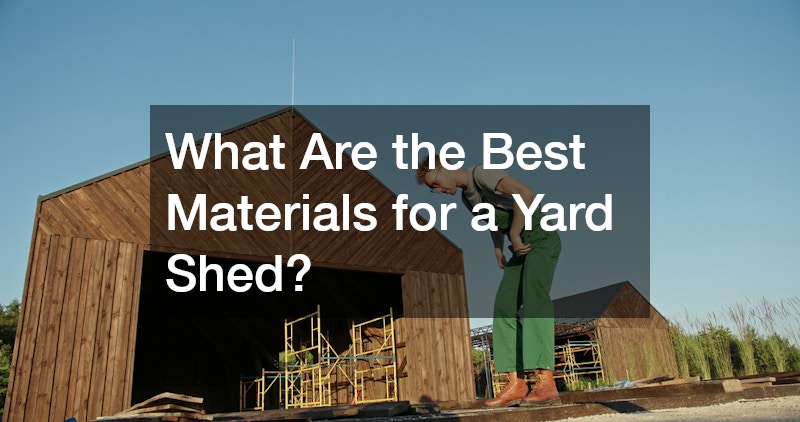In this article, we will explore the most effective materials for building a durable and functional yard shed. Whether you’re looking to store tools, gardening equipment, or other outdoor gear, choosing the right materials is crucial. We will dive into the most common questions and considerations to help you make an informed decision.
1. What are the most durable materials for a yard shed?
1.1 Wood: Classic But Requires Maintenance
Wood remains a time-tested material for yard sheds because of its classic aesthetic appeal. Not only does it blend well with natural landscapes, but it also offers excellent insulation properties for temperature regulation.
However, using wood necessitates regular maintenance to ensure its longevity. This includes treatments to prevent rot and damage from pests like termites.
Many homeowners appreciate the customization options that wood offers, making it a favor choice despite its maintenance needs. To preserve its quality, sealing and painting must be done periodically.
1.2 Metal: Strong and Long-lasting
Metal sheds are known for their incredible strength and durability, which makes them resistant to various wear and tear factors. They offer significant resistance to fire, pests, and warping, making them an ideal choice for many homeowners.
When selecting a metal shed, it is essential to ensure that it is properly treated to prevent rust over time. Galvanized or stainless steel are popular choices because they are coated to resist moisture-related degradation.
Though metal may seem less aesthetically versatile than wood, its robustness in severe weather conditions often outweighs aesthetic considerations. Such resilience ensures that items stored inside are well-protected across different seasons.
2. What materials offer the best value for cost in shed construction?
2.1 Resin: Affordable and Low Maintenance
Resin is an incredibly cost-effective choice for building yard sheds, offering affordability without sacrificing functionality. Its lightweight nature makes it easy to assemble, allowing for quick setup.
One key advantage of resin sheds is their minimal maintenance requirement, as they do not rot or rust over time. However, depending on the weight they must bear, resin may not support heavy shelving effectively.
With UV-stabilized options available, resin sheds can resist fading in sunlight, maintaining their appearance longer than some other materials. This stability ensures the shed remains an attractive and functional addition to your outdoor space.
2.2 Vinyl: Cost-Effective and Weather-Resistant
Vinyl sheds strike a balance between cost and durability, offering weather resistance at a fraction of the price. Such resistance ensures that vinyl sheds can withstand heavy rain and intense sunlight without substantial wear.
They are easy to clean, requiring just occasional washing to maintain appearance and functionality. Over time, however, exposure to sunlight can result in color fading, though this does not necessarily impact structural integrity.
Moreover, vinyl’s smooth finish and variety of color choices make it an attractive option for homeowners looking for customizable aesthetics. This adaptability helps blend the shed seamlessly with the existing landscape of your yard.
3. How do environmental factors affect the choice of materials for a yard shed?
3.1 Climate Considerations: Hot, Rainy, or Snowy Areas
Regardless of where you live, understanding how climate affects shed materials is critical to making a suitable choice. In hotter climates, materials with cooling properties or low thermal conductivity are ideal to prevent heat build-up indoors.
For areas with heavy precipitation, selecting a material resistant to water damage is essential to prolong the shed’s lifespan. Metal, with its non-porous nature, is often preferred in such conditions to prevent mildew and decay.
Meanwhile, snowy regions benefit from materials that hold up well under heavy weight and cold temperatures, such as steel, which provides durability without compromising structural integrity. Adequate insulation helps maintain inside conditions conducive for storage, regardless of external temperatures.
3.2 Eco-Friendly Options: Sustainable Material Choices
For environmentally conscious homeowners, opting for sustainable materials can reduce the carbon footprint associated with shed construction. Recycled metal or FSC-certified wood are popular choices that minimize environmental impact.
These materials not only contribute to environmental conservation but often come with added benefits like enhanced durability and unique finishes. The use of eco-friendly stains or paints can further align with sustainable practices.
Additionally, installing features like solar panels or rainwater collection systems can optimize your shed’s sustainability. Options like these provide functional benefits while supporting a greener environment.
Conclusion
Choosing the right material for your yard shed depends on a variety of factors such as durability, cost, and environmental impact. This article has addressed common concerns and questions to guide you towards the best decision for your specific needs and geographic location.

